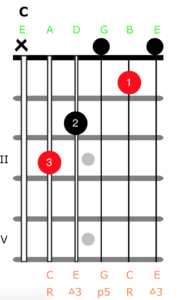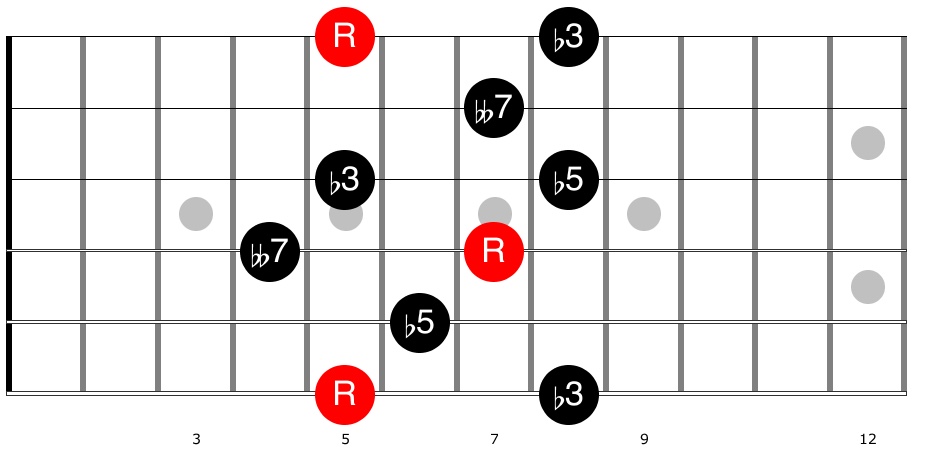In order to be able to play arpeggios, you should first understand what arpeggios are.
Arpeggios are chord tones that are played individually in a specific order. You can look up the guitar chords here.
I’m doing an example with a C major Chord.
I’m doing an example here with a C major chord.

At the bottom of the first line you can see the notes. So here we have a C, E, G, C, E. We have 2x a C, 2x an E and once a G ‚tone‘.
If we play these notes individually now, we would have a strange order, but that does not mean that it is not an arpeggio. On the other hand, it is difficult to play these notes individually because we still have open strings in them. (An open string is a played string that is not pressed by a finger. So it just sounds ‚open‘.)
If we play the intervals one after the other, i.e. R, 3, 5, we would have to change the entire fingering a little.
If you have no clue, what aninterval is, you can look it up right here -> Intervals

All red notes are root notes. That means, in this case ‚Bb‘ (or in the European area B).
If you want the arpeggio on C, then move the entire arpeggio to the 3rd fret.
In the third fret on the A string is the C. You can read about other notes here -> All_notes_on_the_ guitar-chart
All blue notes are thirds. With these you determine whether the arpeggio or the chord will be major or minor.
And finally, all green notes are fifths. The 5th note in the scale.
If you now all play exactly in this order, then you have the intervals -> 1 (Root), 3 (Third), 5 (Fifth), 1 , 3 , 5 , 1 . The same notes (1, 3, 5) are also played twice (not at the same time!), But in octaves and in the ‚correct‘ order.
4 sound arpeggio (7th arpeggios)
4 sound or simply 7 arpeggios are called arpeggios that have 4 notes – instead of just 3 notes, as with the 3 sound.
In jazz, 7th Chords/Arpeggios are used very often. Accordingly, we also play the 4 sound arpeggios over these chords.
If you would like to play arpeggios over 3 sounds, 4 sounds, you can of course do that too. It also works the other way around. However, you should learn the Harmonic theory first. With a major Chord it could be Major7 or Dominant7, depending on the step of the chord. But you’ll find that in another threat .

In this example we see a C major 7 arpeggio. Here the intervals remain the same as in the major arpeggio, but we add an additional note. In this case the 7th tone.
I practiced 7 different patterns. All derived from the scale (you can also find the scales later in the Harmonic theory).
Depending on where you are on the fretboard, you should choose one. It does, for example. No point in playing an arpeggio on the 1st fret and then the next on the 8th fret. Therefore there are different ‚Shapes‘ or ‚Patterns‘ that you can use to stay as close as possible to the previous one.
Major7 Arpeggios Chart

It is best to learn all 7 shapes very well. If you can play through all 7 arpeggios without playing an error, then you can move on to the next one.
Dominant7 arpeggios chart

The dominant 7 arpeggio differs from the major 7 by only one note, namely the seventh (the 7th note on the major scale) is lowered by a semitone. So 7 becomes -> b7.
The scale that is major but still has a b7 is called ‚Mixolydian‘. You can find all of these scales on the7 Modes in Major Blog entry.
As the last arpeggio, let’s look at the minor (or minor).
Minor7 arpeggios chart

Perhaps someone has already noticed that the difference between dominant 7 and minor 7 is just a single tone. Namely the third (3). If you lower the third from 3 to b3, it becomes a minor.
You should know the following arpeggios, preferably in all 7 positions / shapes:
Maj7 = 1,3,5,7
Dom7 = 1,3,5, b7
Min7 = 1, b3.5, b7
Min7b5 = 1, b3, b5, b7
Dim7 = 1, b3, b5, bb7
MinMaj7 = 1, b3,5,7
Dom7sus4 = 1,4,5, b7
Maj7 # 5 = 1.3, # 5.7
Maj7b5 = 1.3, b5.7
Dom7 # 5 = 1,3, # 5, b7
Dom7b5 = 1.3, b5, b7
Remember; always starts with major 7. Then find out which intervals the ’new‘ arpeggio needs. E.g. Minor7b5 -> 1, b3, b5, b7. Now try to derive everything from the Major 7 arpeggio.
The 1 (root note) remains. The 3rd note goes one fret lower, as do the 5th and 7th notes. So you can find out each of these arpeggios very easily. Of course it takes time to memorize all of these arpeggios, but if you have the first 2-3 arpeggios under control, it becomes easier to memorize the next.
Permutations
Of course, arpeggios don’t always have to be played in the ‚correct‘ order.
There is no right or wrong order, but you should first play the arpeggios in the correct order so that you can get used to them and hear and recognize them better.
There are so-called permutations for this. Instead of always playing 1, 3, 5, you can also choose other sequences:
With the triads:
- 135 153
- 315 351
- 513 531
With the four chords:
- 1357 1375 1537 1573 1753 1735
- 3157 3175 3517 3571 3751 3715
- 5317 5371 5137 5173 5713 5731
- 7351 7315 7531 7513 7153 7135
You can calculate the number of different combinations with faculty. If you have 3 sounds (i.e. 3 notes), then it is 3! = 1 * 2 * 3 = 6 combinations . With four notes (4 notes per arpeggio) it would be 4! = 1 * 2 * 3 * 4 = 24 combinations . Etc.
Support me on Patreon and get the original Videos, PDFs, Guitar Pro Files and Neck Diagram for each Post!


Keine Kommentare